FCC to investigate after the Apple iPhone 7 and other models spew RF radiation in tests

The men in the lead pajamas are going to be investigating after the Chicago Tribune tested several smartphones for radiofrequency (RF) radiation. The newspaper discovered something that might be alarming; RF radiation emanating from the Apple iPhone 7 not only exceeded the legal safety limit, it also was double the amount of radiation that Apple's own testing showed that the device leaked. That is based on filings with federal regulators made by the company.
The Tribune points out that the FCC states on its website that any handset approved for sale will never exceed the maximum level of radiation exposure that is considered safe. However, four iPhone 7 units were tested by the Tribune and all of them leaked radiation over that level. The FCC responded to the Tribune's data by stating that it would begin conducting its own tests over the next two months.
The Samsung Galaxy S8 had the worse score of handsets measured 2mm away
The Tribune tested 11 different phones including the iPhone 7, iPhone X, iPhone 8, iPhone 8 Plus, Samsung Galaxy S9, Samsung Galaxy S8, Samsung Galaxy J3, Moto E5 Play, Moto G6 Play, Moto E5 and the BLU Vivo 5 Mini. The phones were each tested to see the amount of RF radiation that leaked 2mm, 5mm, 10mm and up to 15mm away. The 2mm test was done to simulate how much radiation a person might receive if they placed their phone in a shirt or pants pocket. The Tribune says that at that distance, most of the devices it tested exceeded the RF radiation limits by a large amount. The Tribune recommends that smartphone owners refrain from carrying their handsets in a pocket. Because the standards for testing handsets for RF radiation were created in the 1990s when people wore them on a belt clip, the FCC allows new phones to be tested for radiation from a distance as far as 25mm away.

How RF radiation compares to other kinds of radiation
The FCC limit on radiation is "1.6 watts per kilogram averaged over one gram of tissue." The testing reported by the Tribune found that the iPhone 7 exceeded this limit when tested both 2mm and 5mm away. In many of the tests, the phone's radiation level was double the amount that is deemed to be safe by the FCC. The iPhone 8 Plus came in under the 1.6W/kg figure during its testing while the Samsung Galaxy S9 did well from 15mm away, but failed at a distance of 2mm.
The worst score of 8.22W/kg belonged to the Samsung Galaxy S8 which produced this amount of RF radiation from 2mm away. Some Apple and Motorola phones went through a second round of modified tests based on feedback from the respective manufacturer; based on those results, the Moto G6 Play did very well (.25W/kg from 5mm and .53W/kg from 2mm). The BLU Vivo 5 mini's radiation test also came in under the FCC's limits.
When the Tribune presented the results to Apple, the company told the paper how to activate sensors in the iPhone 7 that reduce the power of the device. But even after making the change, this model still emitted too much RF radiation. Apple issued a statement saying that the Tribune's tests "were inaccurate due to the test setup not being in accordance with procedures necessary to properly assess the iPhone models. All iPhone models, including iPhone 7, are fully certified by the FCC and in every other country where iPhone is sold. After careful review and subsequent validation of all iPhone models tested in the (Tribune) report, we confirmed we are in compliance and meet all applicable … exposure guidelines and limits."
Samsung responded to the tests by making the following statement: "Samsung devices sold in the United States comply with FCC regulations. Our devices are tested according to the same test protocols that are used across the industry."
While it isn't clear whether exposure to RF radiation can cause problems to humans, at high levels it can heat up tissue. Most at risk are eyes and the testes because they do not disperse heat well. You might recall that last year, a study conducted by the National Institute of Environmental Health Science (NIH)/National Toxicology Program (NTP) found that male mice blasted with cellphone radiation had a slight increase in the occurrence of a rare heart tumor. The fact that the test did not show a clear connection between cellphones and cancer was highlighted by the actions of the American Cancer Society's chief medical officer, Dr. Otis Brawley. Dr. Brawley told reporters, "I am actually holding my cellphone up to my ear."
While a new phone must be tested for RF radiation before it can be launched in the U.S., the manufacturer is allowed to pick the testing lab. Even worse, only one unit needs to pass the test so that millions more of a particular model can be sold.












Things that are NOT allowed: